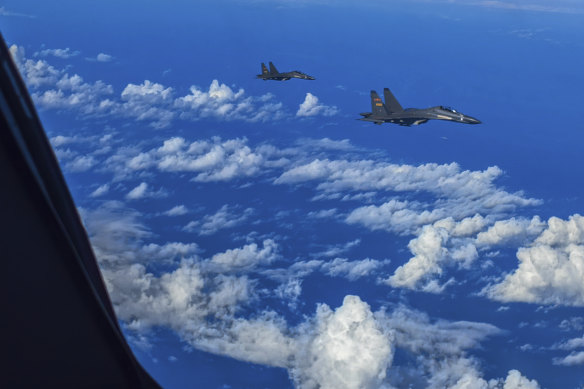In 1921, the Communist Party of China was founded by a small group of revolutionaries in a house in the French Concession in Shanghai.
Their first party congress was raided by French police, but with the support of the Soviet Union, the movement grew to defeat the Chinese state, the Republic of China, and its ruling party, the Chinese Nationalists, and establish the People’s Republic of China in 1949. The Chinese Nationalists retreated to Taiwan to maintain the Republic of China in exile.
Chinese fighter pilots conduct combat training exercises around Taiwan.Credit:AP
Also in 1921, the League for the Establishment of a Taiwan Parliament submitted the first of 15 petitions to the Imperial Diet in Tokyo for self-government for Taiwan.
Taiwan had become a colonial territory of Japan in 1895, after the island was ceded by the Qing empire following its defeat by Japan in the 1894 war.
The League had several thousand members at its peak, including the leading citizens of Taiwan at the time, and delegations of hundreds of Taiwanese travelled to Tokyo each year to meet with Diet members and present their petition to the House of Peers.
Many liberal Japanese politicians and scholars supported Taiwan’s bid for self-government, but the government strongly opposed it. At the first submission, Taiwan’s governor-general, Den Kenjiro, remonstrated with the Peers committee that a Taiwan parliament was “nothing more than a scheme to transform the island into an independent country not dissimilar to England’s Australia or Canada”.
Taiwan’s colonial story was one of development and resistance. The Japanese imperial government almost bankrupted itself pouring resources into Taiwan in the 1900s while fighting militia resistance. By the 1920s and 1930s, resistance had developed into the pursuit of self-government. In this period, a syncretic liberalism flourished in Taiwan’s salons and newspapers, bringing together leading Chinese, Japanese, European and American thinkers of the era.
By the mid-1930s, Japan had taken its turn to militarist extremism. Taiwan’s colonial civil society was forcefully suppressed, and the last self-government petition was 1934. Japan invaded China in 1937, and soon the Taiwanese were fighting in the Japanese imperial army in WWII. Around a thousand Taiwanese were interned in Australia for the duration of the war as imperial subjects.
The allies who defeated Japan in 1945 included the Republic of China, who took control of Taiwan in the first attempt at unification. The results were disastrous. Taiwan’s economy collapsed with hyperinflation and in 1947 the Taiwanese launched an uprising against the Chinese Nationalist authorities that was crushed at the cost of tens of thousands of Taiwanese and Chinese lives. It was then, in 1949, that the national government of the Republic of China arrived, fleeing the Communists, eventually spurring around a million Nationalist refugees to join the population of five million Taiwanese.
In the post-WWII era, Taiwan was governed under the Nationalists’ military dictatorship, but its story continued to be one of development and resistance. The economy boomed, while the liberal ideas of democracy and self-determination from the Japanese era motivated continuing activism, often with the support of liberal-minded Chinese who had fled the communists.
Just like a new post-WWII generation in Australia sought national renewal in the 1970s, the democracy movement was spurred in Taiwan in the same period, and in 1987, martial law ended and through far-reaching constitutional reform, Taiwan achieved democracy.
In the 1990s, the public mood was to look forward not backward, but Taiwanese democratic politics soon became bitterly divisive, beset by unresolved schisms and historical trauma. But Taiwan is still a democracy, and in the last decade, the Taiwanese have embarked upon a process of truth and reconciliation that suffuses their politics, cultural life, and public institutions.
Taiwan’s 20th century story parallels Australia’s: imperialism, injustice and war, modernisation and the pursuit of identity and self-determination. Taiwan has arrived at a place that geopolitically couldn’t be more different but is socially surprisingly similar, and in their journey, harder than ours in many ways, the Taiwanese people have much to teach Australians.
However, Beijing is determined to unify Taiwan with China a second time. The Communist Party of China offers an alternative vision of the future, not of imperfect liberal democratic progress but a fervent vision of communist modernity. For Beijing, Taiwan’s 20th century history of political and social progress is the wrong history. As the Chinese ambassador said at the National Press Club, after unification its 24 million people will be required to erase it from their minds and recite a different story of themselves, not their own, but as symbols of the CCP’s leadership of China to superpower status.
Australians in business, government, the media and universities will also need to learn the ‘correct understanding’ of Taiwan’s story, certainly not the one here, in order to maintain, as Beijing calls them, positive relations with China. The people of Taiwan are in a fight for their future and their past. It is nothing less that the future of the liberal project in the 21st century, and it is one in which Australians have a direct stake.
Mark Harrison is Senior Lecturer in Chinese Studies at the University of Tasmania.
The Morning Edition newsletter is our guide to the day’s most important and interesting stories, analysis and insights. Sign up here.
Most Viewed in World
From our partners
Source: Read Full Article
